- system information
- process
- CLSID
regedit- Set
%USERPROFILE%as${HOME}for cygwin - PuTTy
- disable screensaver
- Remove Graphics card context menu
- Set Environment Variables
- setx problem
- whoami check SID
- fingerprint pro
- enable gadgets
- issue about
"profile.d\Active"' is not recognized as an internal or external command - stop windows beep
- outlook move hubbar to bottom
- Set
shell- tricky
- troubleshooting
reference:
system information
- 20 Useful wmic command examples in Windows | Cheat Sheet
- MS-DOS and Windows command line wmic command
- Find The Manufacturer, Model, Name And System Type Using The Command Prompt
- How to Find Your Windows 10 PC Hardware and System Specs
- How to get full PC memory specs (speed, size, type, part number, form factor) on Windows 10
- 4 Ways to Find Number of Cores in your CPU on Windows 10
- View Disk Properties and LUN Information in Windows
- Get mac address from command line (CMD)
- How to check a PC's hard drive model, serial number, firmware version, and more using Command Prompt
[!TIP|label:memorychip]
- supported types:
ID TYPE 0 Unknown 1 Other 2 DRAM 3 Synchronous DRAM 4 Cache DRAM 5 EDO 6 EDRAM 7 VRAM 8 SRAM 9 RAM 10 ROM 11 Flash 12 EEPROM 13 FEPROM 14 EPROM 15 CDRAM 16 3DRAM 17 SDRAM 18 SGRAM 19 RDRAM 20 DDR 21 DDR2 22 DDR2 FB-DIMM 24 DDR3 25 FBD2 26 DDR4
- supported form factors:
ID FORM 0 Unknown 1 Other 2 SIP 3 DIP 4 ZIP 5 SOJ 6 Proprietary 7 SIMM 8 DIMM 9 TSOP 10 PGA 11 RIMM 12 SODIMM 13 SRIMM 14 SMD 15 SSMP 16 QFP 17 TQFP 18 SOIC 19 LCC 20 PLCC 21 BGA 22 FPBGA 23 LGA 24 FB-DIMM
> wmic computersystem
AdminPasswordStatus AutomaticManagedPagefile AutomaticResetBootOption AutomaticResetCapability BootOptionOnLimit BootOptionOnWatchDog BootROMSupported BootStatus BootupState Caption ChassisBootupState ChassisSKUNumber CreationClassName CurrentTimeZone DaylightInEffect Description DNSHostName Domain DomainRole EnableDaylightSavingsTime FrontPanelResetStatus HypervisorPresent InfraredSupported InitialLoadInfo InstallDate KeyboardPasswordStatus LastLoadInfo Manufacturer Model Name NameFormat NetworkServerModeEnabled NumberOfLogicalProcessors NumberOfProcessors OEMLogoBitmap OEMStringArray PartOfDomain PauseAfterReset PCSystemType PCSystemTypeEx PowerManagementCapabilities PowerManagementSupported PowerOnPasswordStatus PowerState PowerSupplyState PrimaryOwnerContact PrimaryOwnerName ResetCapability ResetCount ResetLimit Roles Status SupportContactDescription SystemFamily SystemSKUNumber SystemStartupDelay SystemStartupOptions SystemStartupSetting SystemType ThermalState TotalPhysicalMemory UserName WakeUpType Workgroup
3 TRUE TRUE TRUE TRUE {0, 0, 0, 0, 0, 0, 0, 0, 0, 0} Normal boot MY-WINDOWS 3 Default string Win32_ComputerSystem 480 AT/AT COMPATIBLE MY-WINDOWS computer.com 3 TRUE 3 FALSE FALSE 3 Supermicro SYS-1028U-E1CRTP+ MY-COMUTER TRUE 32 2 {"Intel Haswell/Wellsburg/Grantley", "Supermicro motherboard-X10 Series"} TRUE -1 4 4 3 0 3 Windows User 1 -1 -1 {"LM_Workstation", "LM_Server", "NT", "Server_NT"} OK Default string Default string x64-based PC 3 120139976704 6
REM computer system product
> wmic csproduct
Caption Description IdentifyingNumber Name SKUNumber UUID Vendor Version
Computer System Product Computer System Product S2xxxxxxxxxxxxx SYS-xxxxU-Exxxxx+ 00000000-0000-0000-0000-0xxxxxxxxxxx Supermicro 0123456789
> wmic bios
BiosCharacteristics BIOSVersion BuildNumber Caption CodeSet CurrentLanguage Description EmbeddedControllerMajorVersion EmbeddedControllerMinorVersion IdentificationCode InstallableLanguages InstallDate LanguageEdition ListOfLanguages Manufacturer Name OtherTargetOS PrimaryBIOS ReleaseDate SerialNumber SMBIOSBIOSVersion SMBIOSMajorVersion SMBIOSMinorVersion SMBIOSPresent SoftwareElementID SoftwareElementState Status SystemBiosMajorVersion SystemBiosMinorVersion TargetOperatingSystem Version
{7, 11, 12, 15, 16, 17, 19, 23, 24, 25, 26, 27, 28, 29, 32, 33, 40, 42, 43} {"- 1072009", "BIOS Date: 06/08/18 21:36:11 Ver: 05.0000B"} BIOS Date: 06/08/18 21:36:11 Ver: 05.0000B BIOS Date: 06/08/18 21:36:11 Ver: 05.0000B 255 255 American Megatrends Inc. BIOS Date: 06/08/18 21:36:11 Ver: 05.0000B TRUE 20180608000000.000000+000 Sxxxxxxxxxxxxx2 3.1 3 0 TRUE BIOS Date: 06/08/18 21:36:11 Ver: 05.0000B 3 OK 5 6 0 - 1072009
> wmic cpu
AddressWidth Architecture AssetTag Availability Caption Characteristics ConfigManagerErrorCode ConfigManagerUserConfig CpuStatus CreationClassName CurrentClockSpeed CurrentVoltage DataWidth Description DeviceID ErrorCleared ErrorDescription ExtClock Family InstallDate L2CacheSize L2CacheSpeed L3CacheSize L3CacheSpeed LastErrorCode Level LoadPercentage Manufacturer MaxClockSpeed Name NumberOfCores NumberOfEnabledCore NumberOfLogicalProcessors OtherFamilyDescription PartNumber PNPDeviceID PowerManagementCapabilities PowerManagementSupported ProcessorId ProcessorType Revision Role SecondLevelAddressTranslationExtensions SerialNumber SocketDesignation Status StatusInfo Stepping SystemCreationClassName SystemName ThreadCount UniqueId UpgradeMethod Version VirtualizationFirmwareEnabled VMMonitorModeExtensions VoltageCaps
64 9 3 Intel64 Family 6 Model 79 Stepping 1 252 1 Win32_Processor 1200 18 64 Intel64 Family 6 Model 79 Stepping 1 CPU0 100 179 2048 25600 0 6 2 GenuineIntel 3201 Intel(R) Xeon(R) CPU E5-2667 v4 @ 3.20GHz 8 8 16 FALSE BFEBFBFF000406F1 3 20225 CPU TRUE CPU1 OK 3 Win32_ComputerSystem MY-COMUTER 16 43 TRUE TRUE
64 9 3 Intel64 Family 6 Model 79 Stepping 1 252 1 Win32_Processor 1200 18 64 Intel64 Family 6 Model 79 Stepping 1 CPU1 100 179 2048 25600 0 6 1 GenuineIntel 3201 Intel(R) Xeon(R) CPU E5-2667 v4 @ 3.20GHz 8 8 16 FALSE BFEBFBFF000406F1 3 20225 CPU TRUE CPU2 OK 3 Win32_ComputerSystem MY-COMUTER 16 43 TRUE TRUE
> wmic os
BootDevice BuildNumber BuildType Caption CodeSet CountryCode CreationClassName CSCreationClassName CSDVersion CSName CurrentTimeZone DataExecutionPrevention_32BitApplications DataExecutionPrevention_Available DataExecutionPrevention_Drivers DataExecutionPrevention_SupportPolicy Debug Description Distributed EncryptionLevel ForegroundApplicationBoost FreePhysicalMemory FreeSpaceInPagingFiles FreeVirtualMemory InstallDate LargeSystemCache LastBootUpTime LocalDateTime Locale Manufacturer MaxNumberOfProcesses MaxProcessMemorySize MUILanguages Name NumberOfLicensedUsers NumberOfProcesses NumberOfUsers OperatingSystemSKU Organization OSArchitecture OSLanguage OSProductSuite OSType OtherTypeDescription PAEEnabled PlusProductID PlusVersionNumber PortableOperatingSystem Primary ProductType RegisteredUser SerialNumber ServicePackMajorVersion ServicePackMinorVersion SizeStoredInPagingFiles Status SuiteMask SystemDevice SystemDirectory SystemDrive TotalSwapSpaceSize TotalVirtualMemorySize TotalVisibleMemorySize Version WindowsDirectory
\Device\HarddiskVolume2 14393 Multiprocessor Free Microsoft Windows Server 2016 Standard 1252 1 Win32_OperatingSystem Win32_ComputerSystem MY-COMUTER 480 TRUE TRUE TRUE 3 FALSE FALSE 256 2 104318100 16628652 123960128 20190906144511.000000+480 20220910175932.131994+480 20221108192010.474000+480 0409 Microsoft Corporation 4294967295 137438953344 {"en-US"} Microsoft Windows Server 2016 Standard|C:\Windows|\Device\Harddisk0\Partition3 0 90 11 7 64-bit 1033 272 18 FALSE TRUE 3 Windows User 003xx-6xxxx-00000-AAxxx 0 0 16777216 OK 272 \Device\HarddiskVolume3 C:\Windows\system32 C: 134101412 117324196 10.0.14393 C:\Windows
> wmic memorychip list
BankLabel Capacity DataWidth Description DeviceLocator FormFactor HotSwappable InstallDate InterleaveDataDepth InterleavePosition Manufacturer MemoryType Model Name OtherIdentifyingInfo PartNumber PositionInRow PoweredOn Removable Replaceable SerialNumber SKU Speed Status Tag TotalWidth TypeDetail Version
P0_Node0_Channel0_Dimm0 17179869184 64 Physical Memory P1-DIMMA1 8 0 0 Micron 0 Physical Memory 18ASF2G72PDZ-2G6E1 1 1D698284 2667 Physical Memory 0 72 128
P0_Node0_Channel1_Dimm0 17179869184 64 Physical Memory P1-DIMMB1 8 0 0 Micron 0 Physical Memory 18ASF2G72PDZ-2G6E1 1 1D69C62D 2667 Physical Memory 3 72 128
P0_Node0_Channel2_Dimm0 17179869184 64 Physical Memory P1-DIMMC1 8 0 0 Micron 0 Physical Memory 18ASF2G72PDZ-2G6E1 1 1D6975D6 2667 Physical Memory 6 72 128
P0_Node0_Channel3_Dimm0 17179869184 64 Physical Memory P1-DIMMD1 8 0 0 Micron 0 Physical Memory 18ASF2G72PDZ-2G6E1 1 1D697650 2667 Physical Memory 9 72 128
P1_Node1_Channel1_Dimm0 17179869184 64 Physical Memory P2-DIMMF1 8 0 0 Micron 0 Physical Memory 18ASF2G72PDZ-2G6E1 1 1D696E47 2667 Physical Memory 15 72 128
P1_Node1_Channel2_Dimm0 17179869184 64 Physical Memory P2-DIMMG1 8 0 0 Micron 0 Physical Memory 18ASF2G72PDZ-2G6E1 1 1D69C141 2667 Physical Memory 18 72 128
P1_Node1_Channel3_Dimm0 17179869184 64 Physical Memory P2-DIMMH1 8 0 0 Micron 0 Physical Memory 18ASF2G72PDZ-2G6E1 1 1D69BD45 2667 Physical Memory 21 72 128
> wmic diskdrive list
Availability BytesPerSector Capabilities CapabilityDescriptions CompressionMethod ConfigManagerErrorCode ConfigManagerUserConfig DefaultBlockSize Description DeviceID ErrorCleared ErrorDescription ErrorMethodology Index InstallDate InterfaceType LastErrorCode Manufacturer MaxBlockSize MaxMediaSize MediaLoaded MediaType MinBlockSize Model Name NeedsCleaning NumberOfMediaSupported Partitions PNPDeviceID PowerManagementCapabilities PowerManagementSupported SCSIBus SCSILogicalUnit SCSIPort SCSITargetId SectorsPerTrack Signature Size Status StatusInfo SystemName TotalCylinders TotalHeads TotalSectors TotalTracks TracksPerCylinder
512 {3, 4} {"Random Access", "Supports Writing"} 0 FALSE Disk drive \\.\PHYSICALDRIVE1 1 SCSI (Standard disk drives) TRUE Fixed hard disk media AVAGO SMC3108 SCSI Disk Device \\.\PHYSICALDRIVE1 2 SCSI\DISK&VEN_AVAGO&PROD_SMC3108\5&1xxxxxxxxxxxxxxx0 1 0 0 1 63 7679261237760 OK MY-COMPUTER 933617 255 14998557105 238072335 255
512 {3, 4} {"Random Access", "Supports Writing"} 0 FALSE Disk drive \\.\PHYSICALDRIVE0 0 SCSI (Standard disk drives) TRUE Fixed hard disk media AVAGO SMC3108 SCSI Disk Device \\.\PHYSICALDRIVE0 3 SCSI\DISK&VEN_AVAGO&PROD_SMC3108\5&1xxxxxxxxxxxxxxx0 1 0 0 0 38 745584 239511336960 OK MY-COMPUTER 117242 105 467795580 12310410 105
or ctrl + r ->
msinfo32
manufacturer
> wmic computersystem get manufacturer
anufacturer
Supermicro
serial number
> wmic bios get serialnumber
SerialNumber
Sxxxxxxxxxxxxx2
product name
> wmic computersystem get model,name,manufacturer,systemtype
uuid
> wmic csproduct get uuid
UUID
00000000-0000-0000-0000-0xxxxxxxxxxx
system slot
> wmic systemslot get slotdesignation,currentusage,description,status
CurrentUsage Description SlotDesignation Status
4 System Slot RSC-R1UW-2E16 SLOT1 PCI-E X16 OK
3 System Slot RSC-R1UW-2E16 SLOT2 PCI-E X16 OK
3 System Slot RSC-R1UW-E8R SLOT1 PCI-E X8 OK
4 System Slot AOC-URN2-i4GXS SLOT1 PCI-E 3.0 X8 OK
cpu
> wmic cpu get DeviceID,NumberOfCores,NumberOfLogicalProcessors,Manufacturer,Name,ProcessorId
DeviceID Manufacturer Name NumberOfCores NumberOfLogicalProcessors ProcessorId
CPU0 GenuineIntel Intel(R) Xeon(R) CPU E5-2667 v4 @ 3.20GHz 8 16 BFEBFBFF000406F1
CPU1 GenuineIntel Intel(R) Xeon(R) CPU E5-2667 v4 @ 3.20GHz 8 16 BFEBFBFF000406F1
REM or
> wmic cpu get SocketDesignation, NumberOfCores, NumberOfLogicalProcessors /Format:List
NumberOfCores=8
NumberOfLogicalProcessors=16
SocketDesignation=CPU1
NumberOfCores=8
NumberOfLogicalProcessors=16
SocketDesignation=CPU2
REM or
> echo %NUMBER_OF_PROCESSORS%
32
or
> Get-WmiObject –class Win32_processor | ft NumberOfCores,NumberOfLogicalProcessors NumberOfCores NumberOfLogicalProcessors ------------- ------------------------- 8 16
os
> wmic os get Caption,CodeSet,Manufacturer,OSArchitecture,SerialNumber
Caption CodeSet Manufacturer OSArchitecture SerialNumber
icrosoft Windows Server 2016 Standard 1252 Microsoft Corporation 64-bit 003xx-6xxxx-00000-AAxxx
system sensor status
> wmic temperature get deviceid,name,status
memory
> wmic memphysical
Caption CreationClassName Depth Description Height HotSwappable InstallDate Location Manufacturer MaxCapacity MaxCapacityEx MemoryDevices MemoryErrorCorrection Model Name OtherIdentifyingInfo PartNumber PoweredOn Removable Replaceable SerialNumber SKU Status Tag Use Version Weight Width
Physical Memory Array Win32_PhysicalMemoryArray Physical Memory Array 3 805306368 805306368 12 6 Physical Memory Array Physical Memory Array 0 3
Physical Memory Array Win32_PhysicalMemoryArray Physical Memory Array 3 805306368 805306368 12 6 Physical Memory Array Physical Memory Array 1 3
> systeminfo | findstr /C:"Total Physical Memory"
Total Physical Memory: 114,574 MB
> wmic computersystem get TotalPhysicalMemory
TotalPhysicalMemory
120139976704
> wmic os get TotalVirtualMemorySize, TotalVisibleMemorySize, FreePhysicalMemory, FreeVirtualMemory, MaxProcessMemorySize
FreePhysicalMemory FreeVirtualMemory MaxProcessMemorySize TotalVirtualMemorySize TotalVisibleMemorySize
104338016 123980828 137438953344 134101412 117324196
disk
> wmic diskdrive get model,index,firmwareRevision,status,interfaceType,totalHeads,totalTracks,totalCylinders,totalSectors,partitions
FirmwareRevision Index InterfaceType Model Partitions Status TotalCylinders TotalHeads TotalSectors TotalTracks
4.68 1 SCSI AVAGO SMC3108 SCSI Disk Device 2 OK 933617 255 14998557105 238072335
4.68 0 SCSI AVAGO SMC3108 SCSI Disk Device 3 OK 117242 105 467795580 12310410
via diskpart
> diskpart DISKPART> list volume Volume ### Ltr Label Fs Type Size Status Info ---------- --- ----------- ----- ---------- ------- --------- -------- Volume 0 E New Volume NTFS Simple 7151 GB Healthy Volume 1 System Rese NTFS Partition 500 MB Healthy System Volume 2 C NTFS Partition 221 GB Healthy Boot DISKPART> list disk Disk ### Status Size Free Dyn Gpt -------- ------------- ------- ------- --- --- Disk 0 Online 223 GB 0 B Disk 1 Online 7151 GB 0 B * * DISKPART> select disk 0 Disk 0 is now the selected disk. DISKPART> detail disk AVAGO SMC3108 SCSI Disk Device Disk ID: 000B6070 Type : RAID Status : Online Path : 1 Target : 0 LUN ID : 0 Location Path : PCIROOT(0)#PCI(0200)#PCI(0000)#RAID(P01T00L00) Current Read-only State : No Read-only : No Boot Disk : Yes Pagefile Disk : Yes Hibernation File Disk : No Crashdump Disk : Yes Clustered Disk : No Volume ### Ltr Label Fs Type Size Status Info ---------- --- ----------- ----- ---------- ------- --------- -------- Volume 1 System Rese NTFS Partition 500 MB Healthy System Volume 2 C NTFS Partition 221 GB Healthy Boot DISKPART> select disk 1 Disk 1 is now the selected disk. DISKPART> detail disk AVAGO SMC3108 SCSI Disk Device Disk ID: {057A21CC-17C6-45E2-893C-D68B128CAD35} Type : RAID Status : Online Path : 1 Target : 1 LUN ID : 0 Location Path : PCIROOT(0)#PCI(0200)#PCI(0000)#RAID(P01T01L00) Current Read-only State : No Read-only : No Boot Disk : No Pagefile Disk : No Hibernation File Disk : No Crashdump Disk : No Clustered Disk : No Volume ### Ltr Label Fs Type Size Status Info ---------- --- ----------- ----- ---------- ------- --------- -------- Volume 0 E New Volume NTFS Simple 7151 GB Healthy
mac address
> getmac
Physical Address Transport Name
=================== ==========================================================
AC-xx-xx-xx-xx-xx Media disconnected
N/A Hardware not present
0C-xx-xx-xx-xx-xx \Device\Tcpip_{BxxxxxxA-3xx1-4xxF-8xx5-3xxxxxxxxxxA}
process
get the list of programs (wmic)
[12:26:33.40 C:\Windows\SysWOW64]
$ wmic product get name,version
Name Version
ALM-Platform Loader 11.5x 11.52.444.0
icrosoft Lync Web App Plug-in 15.8.8308.577
Google App Engine 1.8.6.0
icrosoft Office Professional Plus 2010 14.0.6029.1000
icrosoft Office OneNote MUI (English) 2010 14.0.6029.1000
...
ps auxf
tasklist> tasklist Image Name PID Session Name Session# Mem Usage ========================= ======== ================ =========== ============ System Idle Process 0 Services 0 4 K System 4 Services 0 8,236 K smss.exe 520 Services 0 1,164 K csrss.exe 864 Services 0 4,340 K wininit.exe 960 Services 0 4,744 K csrss.exe 968 Console 1 11,396 K services.exe 108 Services 0 7,776 K lsass.exe 96 Services 0 22,176 K
stop service & process via powershell
reference:
get service:
PS > Get-Service | Where-Object {$_.name -ilike "*docker*" -and $_.Status -ieq "Running"} Status Name DisplayName ------ ---- ----------- Running docker Docker Engine # or PS > Get-Service | Where-Object {$_.name -ilike "*docker*" -and $_.Status -ieq "Running"} Status Name DisplayName ------ ---- ----------- Running docker Docker Enginestop service:
PS > foreach($svc in (Get-Service | Where-Object {$_.name -ilike "*docker*" -and $_.Status -ieq "Running"})) { $svc | Stop-Service -ErrorAction Continue -Confirm:$false -Force } # or PS > Stop-Service docker -ErrorAction Continue -Confirm:$false -Forceget process
PS > Get-Process | Where-Object {$_.Name -ilike "*docker*"} Handles NPM(K) PM(K) WS(K) CPU(s) Id SI ProcessName ------- ------ ----- ----- ------ -- -- ----------- 644 43 175288 56388 475.31 5080 0 dockerdstop process
PS > Get-Process | Where-Object {$_.Name -ilike "*docker*"} | Stop-Process -ErrorAction Continue -Confirm:$false -Force
restart docker service & process
PS > Stop-Service docker -ErrorAction Continue -Confirm:$false -Force
PS > Get-Process | Where-Object {$_.Name -ilike "*docker*"} | Stop-Process -ErrorAction Continue -Confirm:$false -Force
PS > Start-Service docker
PS > Get-Process | Where-Object {$_.Name -ilike "*docker*"}
Handles NPM(K) PM(K) WS(K) CPU(s) Id SI ProcessName
------- ------ ----- ----- ------ -- -- -----------
371 26 142736 46460 1.06 5828 0 dockerd
restart via batch
reference:
> net stop docker
> net stop com.docker.service
> taskkill /IM "dockerd.exe" /F
> taskkill /IM "Docker for Windows.exe" /F
> net start docker
> net start com.docker.service
> "c:\program files\docker\docker\Docker for Windows.exe"
CLSID
reference CLSID Key (GUID) Shortcuts List for Windows 10 http://www.klapac.funsite.cz/mediawiki/index.php?title=List_of_Windows_10_CLSID_Key_(GUID)_Shortcuts
usage
> explorer.exe shell:::{05d7b0f4-2121-4eff-bf6b-ed3f69b894d9}
or
> explorer.exe /e,::{CLSID key number}
details
regedit
Set %USERPROFILE% as ${HOME} for cygwin
[15:55:36.30 C:\]
> REG ADD HKCU\Environment /v HOME /t REG_EXPAND_SZ /d ^%USERPROFILE^%
PuTTy
Backup PuTTy sessions
> REGEDIT /e "%userprofile%\desktop\putty-registry.reg" HKEY_CURRENT_USER\Software\SimontathamLaunchy PuTTy session as shortcut
> [PuTTy.exe] -load [SessionName]Backup PuTTy session
> REGEDIT /e "%userprofile%\desktop\putty-sessions.reg" HKEY_CURRENT_USER\Software\SimonTatham\PuTTY\Sessions
disable screensaver
reference Configure screensaver command line
> REM Disable the screensaver
> REG ADD "HKCU\SOFTWARE\Policies\Microsoft\Windows\Control Panel\Desktop" /v ScreenSaverIsSecure /t REG_SZ /d 0 /f
> REG ADD "HKCU\SOFTWARE\Policies\Microsoft\Windows\Control Panel\Desktop" /v ScreenSaveActive /t REG_SZ /d 0 /f
or by using autohotkey
CoordMode, Mouse, Screen Loop { ; Move mouse MouseMove, 1, 1, 0, R ; Replace mouse to its original location MouseMove, -1, -1, 0, R ; Wait before moving the mouse again Sleep, 600000 } return-
#Persistent SetTimer, WatchCursor, 100 return Loop { WatchCursor: MouseGetPos,X1 ,Y1 Sleep 10000 MouseGetPos,X2,Y2 if X1=X2 And Y1=Y2 { MouseMove,100,100 Sleep, 10000 MouseMove,200,200 Sleep, 10000 } }
-
Remove Graphics card context menu
Unregister igfxpph.dll
> regsvr32 /u igfxpph.dllRemove register
Setting from regedit
> REG DELETE "HKEY_CLASSES_ROOT\Directory\Background\shellex\ContextMenuHandlers\igfxcui" /fSetting from setx
> REG DELETE "HKEY_CLASSES_ROOT\Directory\Background\shellex\ContextMenuHandlers\igfxcui" /f
Set Environment Variables
Set User Varialbe
> setx VIM_HOME C:\Marslo\MyProgramFiles\Vim\vim74\gvim.exeSet System Variable
> setx /M VIM_HOME C:\Marslo\MyProgramFiles\Vim\vim74\gvim.exe
details
windows default environment variable
setx problem
> setx /M PATH %PATH%;%M2_HOME%\bin
ERROR: Invalid syntax. Default option is not allowed more than '2' time(s).
Type "SETX /?" for usage.
- fix:
> REG ADD "HKEY_LOCAL_MACHINE\SYSTEM\CurrentControlSet\Control\Session Manager\Environment" /v Path /t REG_SZ /d "%path%;%M2_HOME%\bin" /f
whoami check SID
> whoami /user
USER INFORMATION
----------------
User Name SID
================ ===============================================
mj\marslo_jiao S-1-5-21-354581543-3608027983-2995495404-970613
fingerprint pro
URL: www.lenovo.com
Help link: support.lenovo.com
Installation folder: C:\Program Files\Lenovo\Fingerprint Manager Pro\
Uninstaller: "C:\Program Files\InstallShield Installation Information\{314FAD12-F785-4471-BCE8-AB506642B9A1}\setup.exe" -runfromtemp -l0x0409 -removeonly
Estimated size: 70.21 MB
enable gadgets
Windows Registry Editor Version 5.00
[HKEY_CURRENT_USER\Software\Microsoft\Windows\CurrentVersion\Policies\Windows\Sidebar]
"TurnOffSidebar"=-
[HKEY_LOCAL_MACHINE\SOFTWARE\Microsoft\Windows\CurrentVersion\Policies\Windows\Sidebar]
"TurnOffSidebar"=-
issue about "profile.d\Active"' is not recognized as an internal or external command
regedit
[HKEY_LOCAL_MACHINE\SOFTWARE\Microsoft\Command Processor] "Autorun"="@CHCP 65001>nul"cmd
> REG ADD "HKEY_LOCAL_MACHINE\SOFTWARE\Microsoft\Command Processor" /v AutoRun /t REG_SZ /d "@CHCP 65001>nul" /f
stop windows beep
[!NOTE|label:references:]
> net stop beep
> sc config beep start= disabled
outlook move hubbar to bottom
> REG ADD "HKCU\SOFTWARE\Microsoft\Office\16.0\Common\ExperimentConfigs\ExternalFeatureOverrides\outlook" /v "Microsoft.Office.Outlook.Hub.HubBar" /t REG_SZ /d "false" /f
regedit
Windows Registry Editor Version 5.00 [HKEY_CURRENT_USER\SOFTWARE\Microsoft\Office\16.0\Common\ExperimentConfigs\ExternalFeatureOverrides\outlook] "Microsoft.Office.Outlook.Hub.HubBar"="false"
shell
utf-8 in windows terminal
[!TIP]
- references:
- Use UTF-8 code pages in Windows apps
- Using UTF-8 in the Windows Terminal
- Using UTF-8 Encoding (CHCP 65001) in Command Prompt / Windows Powershell (Windows 10)
- Terminal should force pseudoconsole host into UTF-8 codepage by default #1802
- How to use unicode characters in Windows command line?
- Change default code page of Windows console to UTF-8
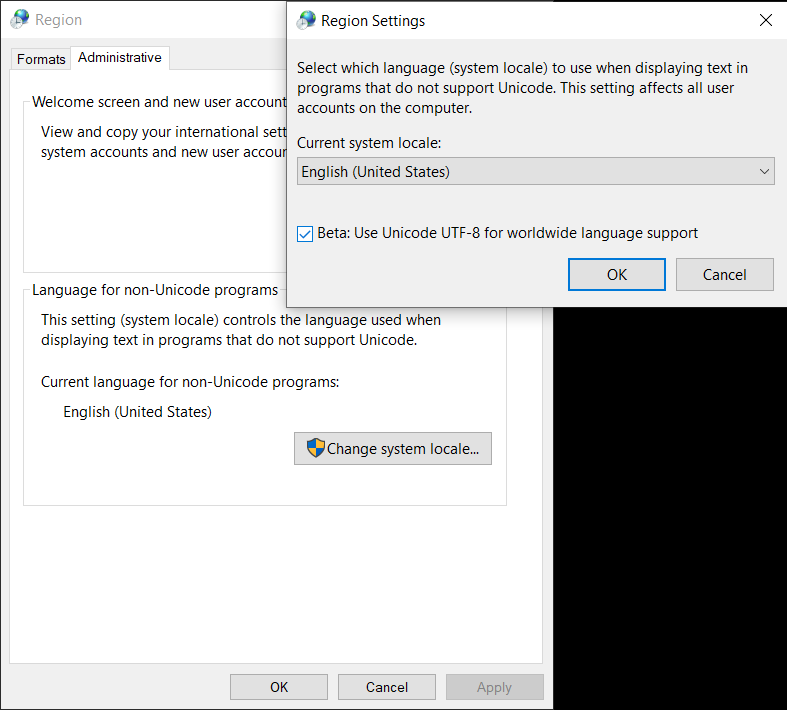
win + r
references:
appfolder
> shell:appfolderstartup folder
> shell:startup > shell:Common Startup
debug in powershell
references:
> Set-PSDebug -Trace 2
show all environment variables
Write-Host "System Environment: "
Get-ChildItem -Path Env:
setup environment via config file by powershell
references:
PS C:\> cat .\test.txt
TEST_A=aa
TEST_B=bb
PS C:\> cat .\test.txt | ForEach-Object {
>> $name, $value = $_ -split '=', 2
>> Set-Content env:\"$name" $value
>> }
example
PS C:\> Get-Content -Path .\test.txt | Foreach-Object { >> $name, $value = $_ -split '=', 2 >> echo "`n>>> $name ~> $value" >> Set-Content env:\"$name" $value >> Get-ChildItem Env:\"$name" >> } >>> TEST_A ~> aa Name Value ---- ----- TEST_A aa >>> TEST_B ~> bb TEST_B bb
tricky
enable LongPaths in windows
[!NOTE|label:references:]
- Maximum Path Length Limitation
- The maximum path of 32,767 characters is approximate
- GetVolumeInformationA function
- How to Make Windows 10 Accept File Paths Over 260 Characters
- Enabling Windows Long Path (Windows 10 - 1803 build)
regedit
> REG ADD "HKLM\SYSTEM\CurrentControlSet\Control\FileSystem" /v LongPathsEnabled /t REG_DWORD /d 0x00000001 /f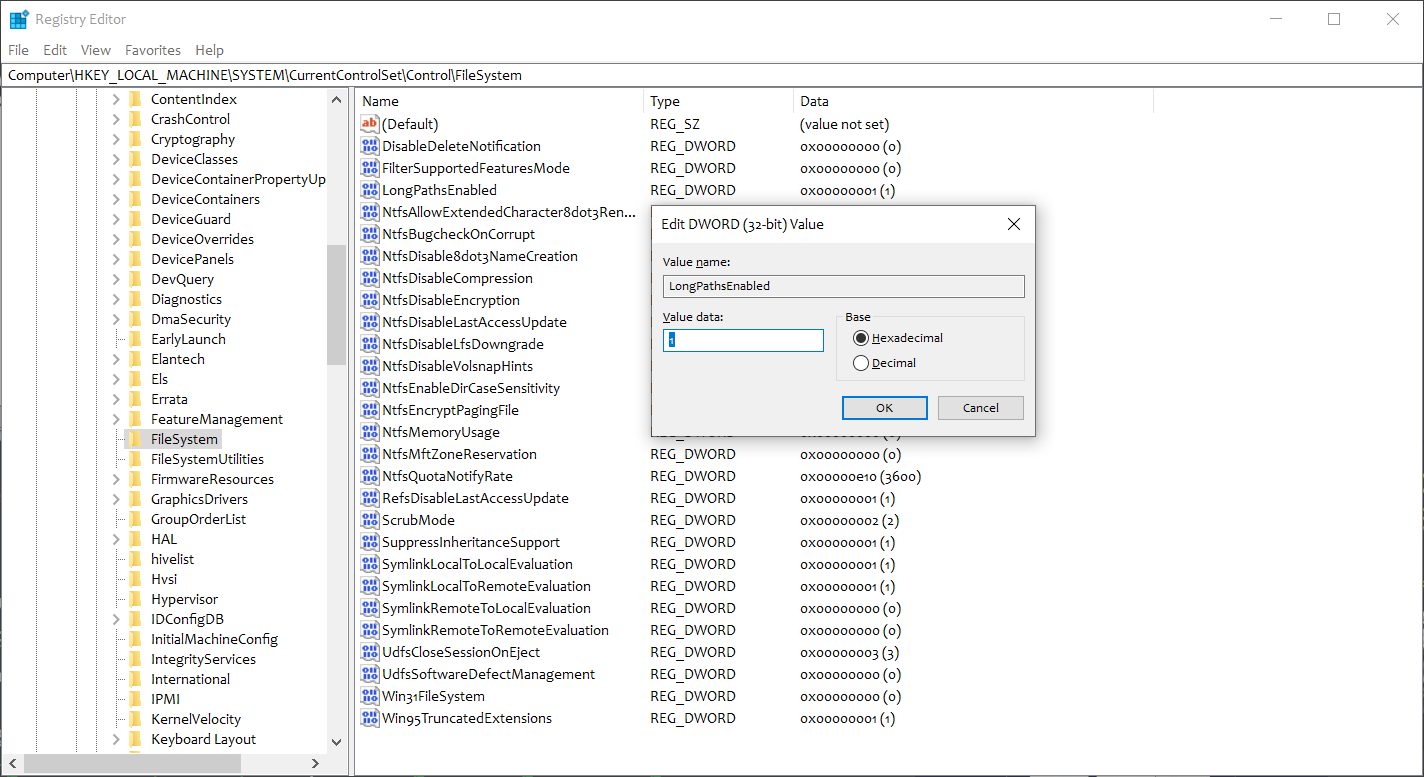
1.2.2.2 -- regedit -> LongPathsEnabled powershell
> New-ItemProperty -Path "HKLM:\SYSTEM\CurrentControlSet\Control\FileSystem" -Name "LongPathsEnabled" -Value 1 -PropertyType DWORD -Forcegpedit.msc
- Local Group Policy Editor -> Computer Configuration -> Administrative Templates -> System > Filesystem
- Enable win32 long paths -> Enabled
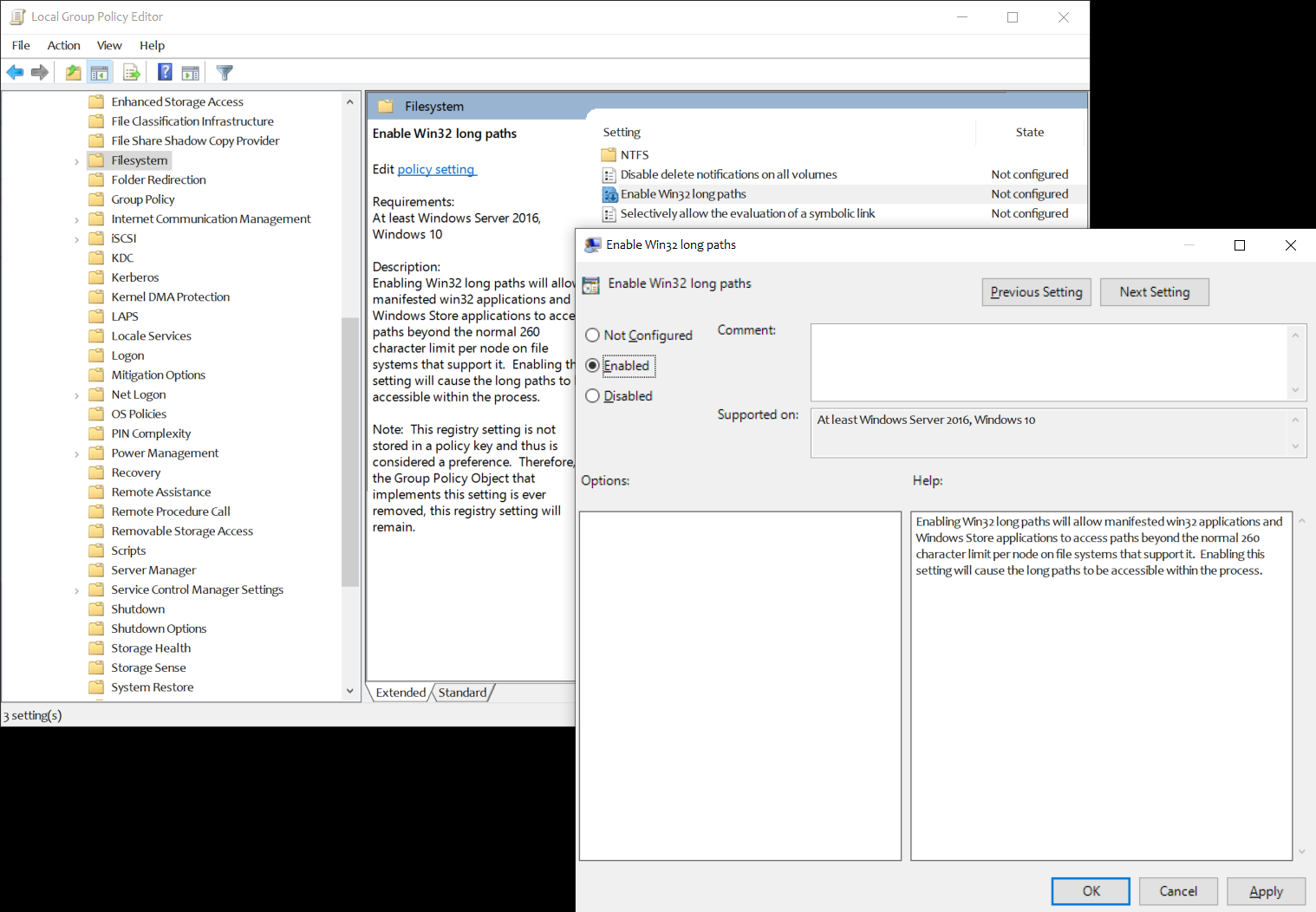
1.2.2.3 -- pgedit.msc -> Enable win32 long paths
Internet Explorer Enhanced Security Configuration is enabled

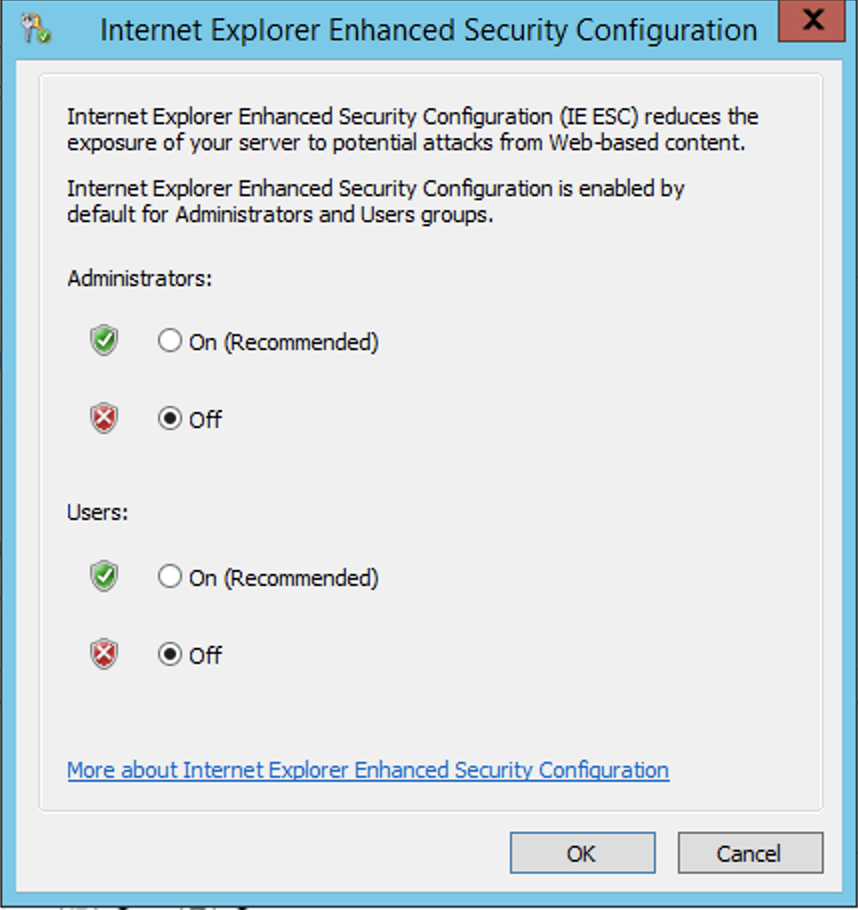
powershell plugins
# 1. 安装 PSReadline 包,该插件可以让命令行很好用,类似 zsh
> Install-Module -Name PSReadLine -Scope CurrentUser -Force
# 2. 安装 posh-git 包,让你的 git 更好用
> Install-Module posh-git -Scope CurrentUser
# 3. 安装 oh-my-posh 包,让你的命令行更酷炫、优雅
> Install-Module oh-my-posh -Scope CurrentUser
openssh for windows
[!TIP|label:references:]
- * Get started with OpenSSH for Windows
- OpenSSH for Windows overview
- OpenSSH Server configuration for Windows Server and Windows
- Tutorial: SSH in Windows Terminal
- [Solved] Add-WindowsCapability failed. Error code = 0x800f0954 – RSAT Fix
- Installing and Configuring OpenSSH on Windows Server 2019
- owerShell/Win32-OpenSSH
- Install Win32 OpenSSH
pre-check
# verify whehter if running as Administrator > (New-Object Security.Principal.WindowsPrincipal([Security.Principal.WindowsIdentity]::GetCurrent())).IsInRole([Security.Principal.WindowsBuiltInRole]::Administrator) True > Get-Command -Noun WindowsCapability CommandType Name Version Source ----------- ---- ------- ------ Cmdlet Add-WindowsCapability 3.0 Dism Cmdlet Get-WindowsCapability 3.0 Dism Cmdlet Remove-WindowsCapability 3.0 Dismcheck openssh versions
> Get-WindowsCapability -Online | Where-Object Name -like 'OpenSSH*' Name : OpenSSH.Client~~~~0.0.1.0 State : NotPresent Name : OpenSSH.Server~~~~0.0.1.0 State : NotPresent # or > Get-WindowsCapability -Name OpenSSH* -Online Name : OpenSSH.Client~~~~0.0.1.0 State : NotPresent DisplayName : OpenSSH Client Description : OpenSSH-based secure shell (SSH) client, for secure key management and access to remote machines. DownloadSize : 1323493 InstallSize : 5301402 Name : OpenSSH.Server~~~~0.0.1.0 State : NotPresent DisplayName : OpenSSH Server Description : OpenSSH-based secure shell (SSH) server, for secure key management and access from remote machines. DownloadSize : 1297677 InstallSize : 4946932
1.2.2.6 -- check openssh version install client and server
> Add-WindowsCapability -Online -Name OpenSSH.Client~~~~0.0.1.0 > Add-WindowsCapability -Online -Name OpenSSH.Server~~~~0.0.1.0 # or via dism ( Deployment Image Servicing and Management tool ) > dism /online /Add-Capability /CapabilityName:OpenSSH.Client~~~~0.0.1.0 Deployment Image Servicing and Management tool Version: 10.0.19041.3570 Image Version: 10.0.19044.3570 [==========================100.0%==========================] The operation completed successfully. > dism /online /Add-Capability /CapabilityName:OpenSSH.Server~~~~0.0.1.0install for windows 2019
[!NOTE|label:references:]
- windows-dev-guide/install.ps1
> choco install -y openssh --prerelease --force --params '/SSHServerFeature /PathSpecsToProbeForShellEXEString:$env:programfiles\PowerShell\*\pwsh.exe' > Import-Module -force (resolve-path /prog*s/openssh*/opensshutils.psd1) > Repair-AuthorizedKeyPermission -file ~/.ssh/authorized_keys > Icacls authorized_keys /remove “NT SERVICE\sshd”
> Install-Module -Force OpenSSHUtils -Scope AllUsers > Set-ExecutionPolicy Bypass > Iwr https://chocolatey.org/install.ps1 -UseBasicParsing | iex > choco install nano -y # start services > Set-Service -Name ssh-agent -StartupType ‘Automatic’ > Set-Service -Name sshd -StartupType ‘Automatic’ > Start-Service ssh-agent > Start-Service sshd- windows-dev-guide/install.ps1
error
0x800f0954:[!NOTE|label:references:]
UseWUServer> Get-ItemProperty -Path HKLM:SOFTWARE\Policies\Microsoft\Windows\WindowsUpdate\AU -Name UseWUServer UseWUServer : 1 PSPath : Microsoft.PowerShell.Core\Registry::HKEY_LOCAL_MACHINE\SOFTWARE\Policies\Microsoft\Windows\WindowsUpdate\AU PSParentPath : Microsoft.PowerShell.Core\Registry::HKEY_LOCAL_MACHINE\SOFTWARE\Policies\Microsoft\Windows\WindowsUpdate PSChildName : AU PSDrive : HKLM PSProvider : Microsoft.PowerShell.Core\Registry > Get-ItemPropertyValue -Path HKLM:SOFTWARE\Policies\Microsoft\Windows\WindowsUpdate\AU -Name UseWUServer 1 # or > REG query HKLM\SOFTWARE\Policies\Microsoft\Windows\WindowsUpdate\AU HKEY_LOCAL_MACHINE\SOFTWARE\Policies\Microsoft\Windows\WindowsUpdate\AU NoAutoUpdate REG_DWORD 0x0 AUOptions REG_DWORD 0x3 ScheduledInstallDay REG_DWORD 0x0 ScheduledInstallTime REG_DWORD 0x3 NoAutoRebootWithLoggedOnUsers REG_DWORD 0x1 DetectionFrequencyEnabled REG_DWORD 0x1 DetectionFrequency REG_DWORD 0x16 UseWUServer REG_DWORD 0x1 > REG query HKLM\SOFTWARE\Policies\Microsoft\Windows\WindowsUpdate\AU /v UseWUServer HKEY_LOCAL_MACHINE\SOFTWARE\Policies\Microsoft\Windows\WindowsUpdate\AU UseWUServer REG_DWORD 0x1DisableWindowsUpdateAccess:> Get-ItemProperty -Path HKLM:SOFTWARE\Policies\Microsoft\Windows\WindowsUpdate\ -Name DisableWindowsUpdateAccess DisableWindowsUpdateAccess : 1 PSPath : Microsoft.PowerShell.Core\Registry::HKEY_LOCAL_MACHINE\SOFTWARE\Policies\Microsoft\Windows\WindowsUp date\ PSParentPath : Microsoft.PowerShell.Core\Registry::HKEY_LOCAL_MACHINE\SOFTWARE\Policies\Microsoft\Windows PSChildName : WindowsUpdate PSDrive : HKLM PSProvider : Microsoft.PowerShell.Core\Registry > Get-ItemPropertyValue -Path HKLM:SOFTWARE\Policies\Microsoft\Windows\WindowsUpdate\ -Name DisableWindowsUpdateAccess 1 # or > REG query HKLM\SOFTWARE\Policies\Microsoft\Windows\WindowsUpdate\ HKEY_LOCAL_MACHINE\SOFTWARE\Policies\Microsoft\Windows\WindowsUpdate DisableWindowsUpdateAccess REG_DWORD 0x1 TargetGroupEnabled REG_DWORD 0x1 TargetGroup REG_SZ SC_Servers WUServer REG_SZ http://msi-wsus03.marvell.com WUStatusServer REG_SZ http://msi-wsus03.marvell.com HKEY_LOCAL_MACHINE\SOFTWARE\Policies\Microsoft\Windows\WindowsUpdate\AU > REG query HKLM\SOFTWARE\Policies\Microsoft\Windows\WindowsUpdate\ /v DisableWindowsUpdateAccess HKEY_LOCAL_MACHINE\SOFTWARE\Policies\Microsoft\Windows\WindowsUpdate DisableWindowsUpdateAccess REG_DWORD 0x1
# set Windows Update Server Key to 0 > Set-ItemProperty -Path HKLM:SOFTWARE\Policies\Microsoft\Windows\WindowsUpdate\AU -Name UseWUServer -Value 0 # Set Disable Windows Update Access to 0 > Set-ItemProperty -Path HKLM:SOFTWARE\Policies\Microsoft\Windows\WindowsUpdate\ -Name DisableWindowsUpdateAccess -Value 0 # restart Windows Update Service > Restart-Service -Name wuauserv -Forceor full process
# get defautl values > $currentWU = Get-ItemPropertyValue -Path "HKLM:\SOFTWARE\Policies\Microsoft\Windows\WindowsUpdate\AU" -Name "UseWUServer" > $currentWUAccess = Get-ItemPropertyValue -Path "HKLM:SOFTWARE\Policies\Microsoft\Windows\WindowsUpdate" -Name "DisableWindowsUpdateAccess" # set Windows Update Server Key to 0 > Set-ItemProperty -Path "HKLM:\SOFTWARE\Policies\Microsoft\Windows\WindowsUpdate\AU" -Name "UseWUServer" -Value 0 # set Disable Windows Update Access to 0 > Set-ItemProperty -Path HKLM:SOFTWARE\Policies\Microsoft\Windows\WindowsUpdate -Name DisableWindowsUpdateAccess -Value 0 # restart Windows Update Service ( wuauserv ) > Restart-Service wuauserv # or > Restart-Service -Name wuauserv -Force # install > Get-WindowsCapability -Name OpenSSH* -Online | Add-WindowsCapability –Online # or > dism /online /Add-Capability /CapabilityName:OpenSSH.Client~~~~0.0.1.0 > dism /online /Add-Capability /CapabilityName:OpenSSH.Server~~~~0.0.1.0 # or > Add-WindowsCapability -Online -Name OpenSSH.Client~~~~0.0.1.0 > Add-WindowsCapability -Online -Name OpenSSH.Server~~~~0.0.1.0 # revert > Set-ItemProperty -Path "HKLM:\SOFTWARE\Policies\Microsoft\Windows\WindowsUpdate\AU" -Name "UseWUServer" -Value $currentWU > Set-ItemProperty -Path HKLM:SOFTWARE\Policies\Microsoft\Windows\WindowsUpdate -Name DisableWindowsUpdateAccess -Value $currentWUAccess > Restart-Service wuauserv # or > Restart-Service -Name wuauserv -Forceupdate help
> Update-Help-
[!NOTE|label:references:]
- * provision.ps1
- ssh-pubkey.ps1
Static-Binaries/openssh/INFO.md
> curl -qfSLO "https://raw.githubusercontent.com/Azathothas/Static-Binaries/main/openssh/openssh_amd_x86_Windows.msi" > curl -qfSLO "https://raw.githubusercontent.com/Azathothas/Static-Binaries/main/openssh/openssh_amd_x86_Windows.zip" # or > Invoke-WebRequest -Uri "https://raw.githubusercontent.com/Azathothas/Static-Binaries/main/openssh/openssh_amd_x86_Windows.msi" -OutFile "openssh.msi" > Invoke-WebRequest -Uri "https://raw.githubusercontent.com/Azathothas/Static-Binaries/main/openssh/openssh_amd_x86_Windows.zip" -OutFile "openssh.zip" > msiexec /i openssh.msi > msiexec /i openssh.msi /l*vx install.log
- download [OpenSSH-Win64.zip](https://github.com/PowerShell/Win32-OpenSSH/releases/download/v9.4.0.0p1-Beta/OpenSSH-Win64.zip)
- extract to `c:\Program Files\OpenSSH-Win32`
- execute as admin
```powershell
cd "c:\Program Files\OpenSSH-Win32"
powershell -executionpolicy bypass
.\install-sshd.ps1
.\ssh-keygen.exe -A
Start-Service ssh-agent
.\ssh-add ssh_host_dsa_key
.\ssh-add ssh_host_rsa_key
.\ssh-add ssh_host_ecdsa_key
.\ssh-add ssh_host_ed25519_key
netsh advfirewall firewall add rule name="SSH Port" dir=in action=allow protocol=TCP localport=22
.\install-sshlsa.ps1
Set-Service sshd -StartupType Automatic
Set-Service ssh-agent -StartupType Automatic
.\FixHostFilePermissions.ps1 -Confirm:$false
.\FixUserFilePermissions.ps1 -Confirm:$false
Start-Service sshd
```
start services
# Start the sshd service > Start-Service sshd > Start-Service ssh-agent # OPTIONAL but recommended: > Set-Service -Name sshd -StartupType 'Automatic' > Set-Service -Name ssh-agent -StartupType 'Automatic' # confirm the firewall rule is configured. it should be created automatically by setup. run the following to verify > if (!(Get-NetFirewallRule -Name "OpenSSH-Server-In-TCP" -ErrorAction SilentlyContinue | Select-Object Name, Enabled)) { Write-Output "Firewall Rule 'OpenSSH-Server-In-TCP' does not exist, creating it..." New-NetFirewallRule -Name 'OpenSSH-Server-In-TCP' -DisplayName 'OpenSSH Server (sshd)' -Enabled True -Direction Inbound -Protocol TCP -Action Allow -LocalPort 22 } else { Write-Output "Firewall rule 'OpenSSH-Server-In-TCP' has been created and exists." }- verify
> Get-Service *ssh* | Where-Object {$_.Status -eq "Running"} Status Name DisplayName ------ ---- ----------- Running sshd OpenSSH SSH Server
- verify
connect via ssh
> ssh domain\username@servername # in wsl $ ssh -o PreferredAuthentications=password -o PubkeyAuthentication=no marslo@server.sample.com marslo@dc5-ssdfw14's password: (c) 2018 Microsoft Corporation. All rights reserved. Clink v1.3.47.d5796b Copyright (c) 2012-2018 Martin Ridgers Portions Copyright (c) 2020-2022 Christopher Antos https://github.com/chrisant996/clink Clink v1.5.18 is available. - To apply the update, run 'clink update'. - To stop checking for updates, run 'clink set clink.autoupdate false'. - To view the release notes, visit the Releases page: https://github.com/chrisant996/clink/releases DOMAIN\marslo@SERVER.SAMPLE.COM C:\Users\marslo>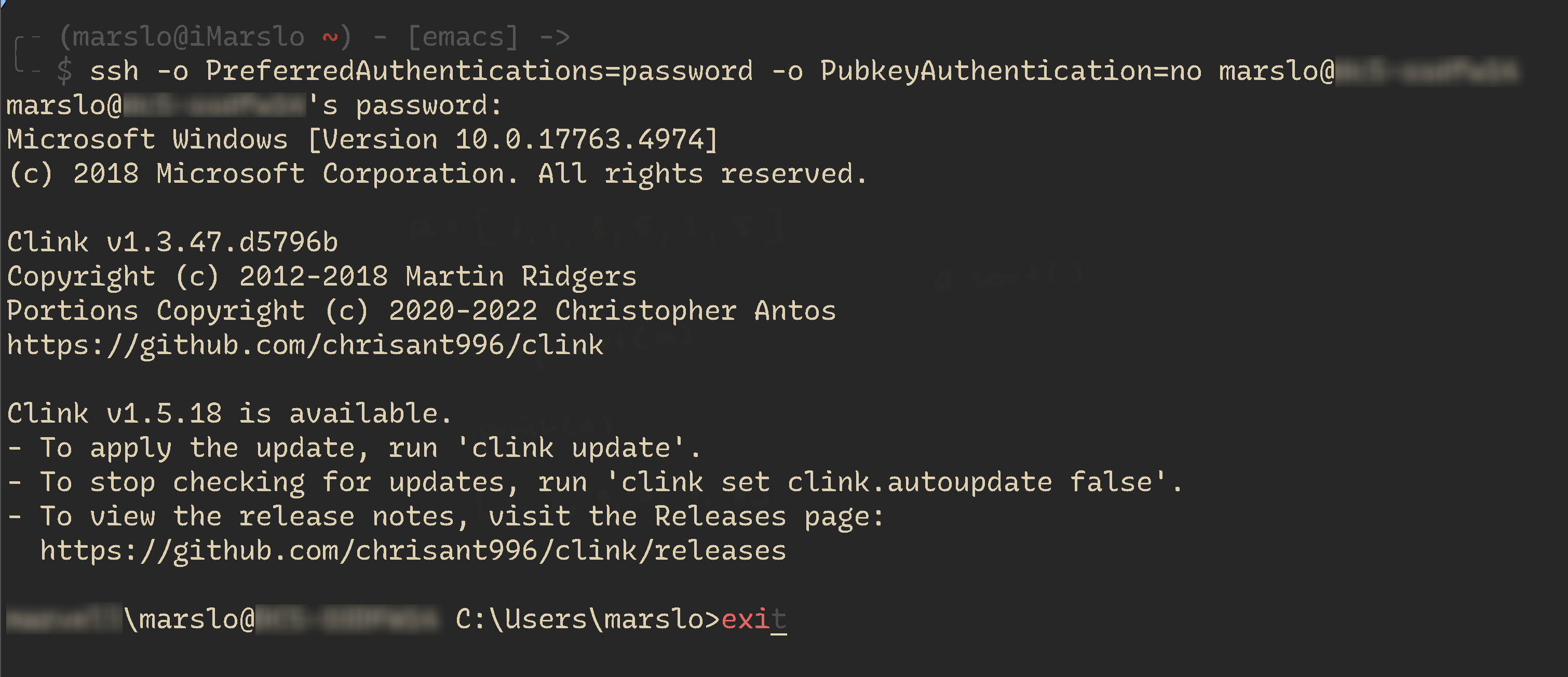
1.2.2.7 -- ssh windows server ssh key
[!NOTE|label:references:]
generate keys
> ssh-keygen -t ed25519 # By default the ssh-agent service is disabled. Configure it to start automatically. # Make sure you're running as an Administrator. > Get-Service ssh-agent | Set-Service -StartupType Automatic # Start the service > Start-Service ssh-agent # This should return a status of Running > Get-Service ssh-agent # Now load your key files into ssh-agent > ssh-add $env:USERPROFILE\.ssh\id_ed25519
standard user
# Get the public key file generated previously on your client > $authorizedKey = Get-Content -Path $env:USERPROFILE\.ssh\id_ed25519.pub # Generate the PowerShell to be run remote that will copy the public key file generated previously on your client to the authorized_keys file on your server > $remotePowershell = "powershell New-Item -Force -ItemType Directory -Path $env:USERPROFILE\.ssh; Add-Content -Force -Path $env:USERPROFILE\.ssh\authorized_keys -Value '$authorizedKey'" # Connect to your server and run the PowerShell using the $remotePowerShell variable > ssh username@domain1@contoso.com $remotePowershelladministrative user
[!NOTE] This example shows the steps for creating the
administrators_authorized_keysfile. This only applies to administrator accounts and must be user instead of the per user file within the user's profile location.# get the public key file generated previously on your client $authorizedKey = Get-Content -Path $env:USERPROFILE\.ssh\id_ed25519.pub # generate the powershell to be run remote that will copy the public key file generated previously on your client to the authorized_keys file on your server $remotePowershell = "powershell Add-Content -Force -Path $env:ProgramData\ssh\administrators_authorized_keys -Value '$authorizedKey';icacls.exe ""$env:ProgramData\ssh\administrators_authorized_keys"" /inheritance:r /grant ""Administrators:F"" /grant ""SYSTEM:F""" # Connect to your server and run the PowerShell using the $remotePowerShell variable ssh username@domain1@contoso.com $remotePowershell > icacls.exe "C:\ProgramData\ssh\administrators_authorized_keys" /inheritance:r /grant "Administrators:F" /grant "SYSTEM:F"troubleshooting
[!NOTE] Permissions for '/path/to/private/key' are too open
REM run as normal user > icacls private-key /inheritance:r > icacls private-key /grant:r "%username%":"(R)"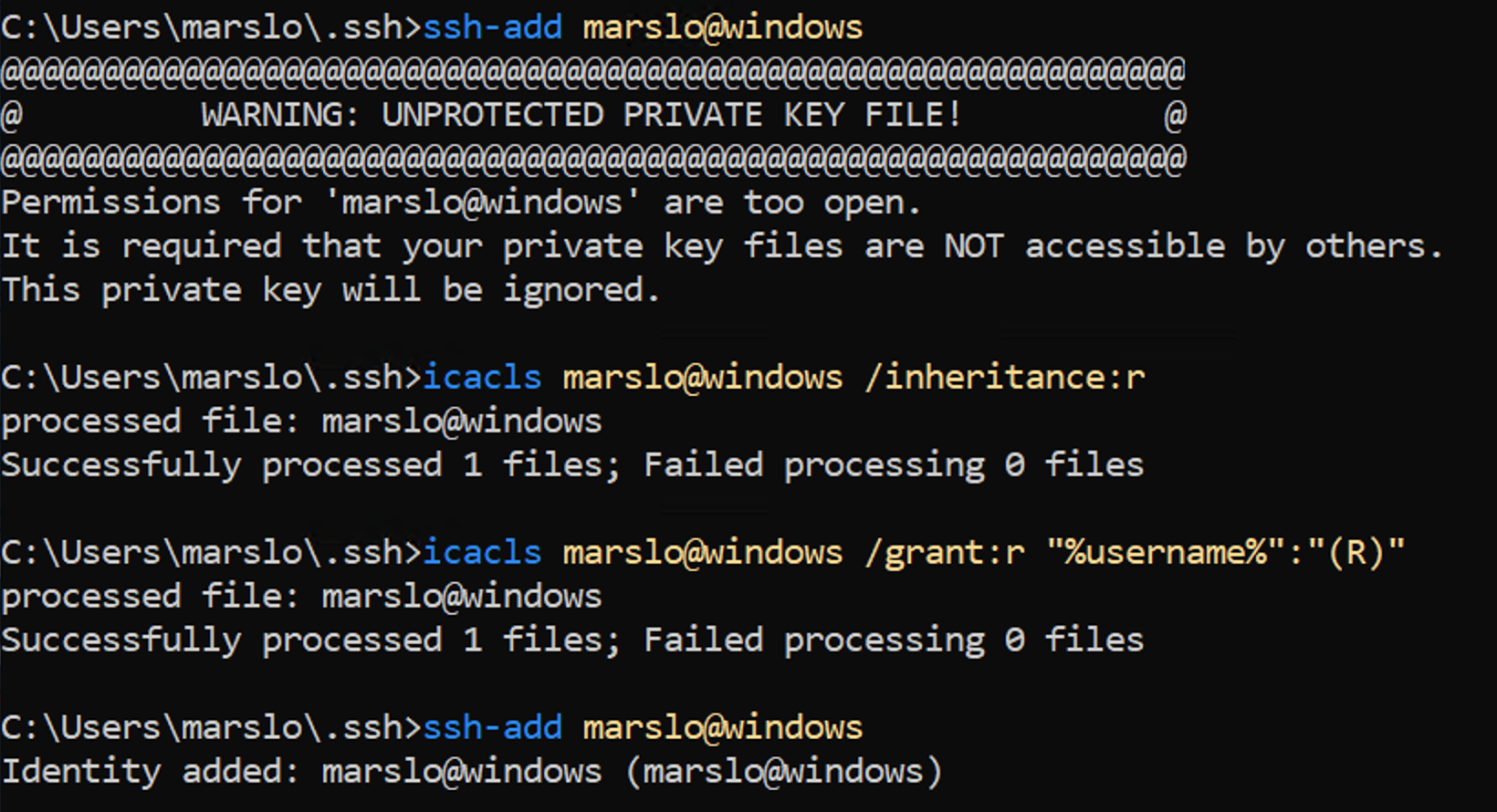
1.2.2.8 -- ssh key -
cmd
::# Set Key File Variable: Set Key="%UserProfile%\.ssh\id_rsa" ::# Remove Inheritance: Icacls %Key% /c /t /Inheritance:d ::# Set Ownership to Owner: :: # Key's within %UserProfile%: Icacls %Key% /c /t /Grant %UserName%:F :: # Key's outside of %UserProfile%: TakeOwn /F %Key% Icacls %Key% /c /t /Grant:r %UserName%:F ::# Remove All Users, except for Owner: Icacls %Key% /c /t /Remove:g "Authenticated Users" BUILTIN\Administrators BUILTIN Everyone System Users ::# Verify: Icacls %Key% ::# Remove Variable: set "Key="powershell
# Set Key File Variable: New-Variable -Name Key -Value "$env:UserProfile\.ssh\id_rsa" # Remove Inheritance: Icacls $Key /c /t /Inheritance:d # Set Ownership to Owner: # Key's within $env:UserProfile: Icacls $Key /c /t /Grant ${env:UserName}:F # Key's outside of $env:UserProfile: TakeOwn /F $Key Icacls $Key /c /t /Grant:r ${env:UserName}:F # Remove All Users, except for Owner: Icacls $Key /c /t /Remove:g Administrator "Authenticated Users" BUILTIN\Administrators BUILTIN Everyone System Users # Verify: Icacls $Key # Remove Variable: Remove-Variable -Name Key-
> cat ~\.ssh\example-key.ecdsa | ssh-add -k - -
# do the following in powerhsell if not already done # Set-ExecutionPolicy RemoteSigned # NOTE: edit the path in this command if needed $sshFiles=Get-ChildItem -Path "$env:userprofile\.ssh" -Force $sshFiles | % { $key = $_ & icacls $key /c /t /inheritance:d & icacls $key /c /t /grant "${echo $env:username}":F & icacls $key /c /t /remove Administrator "Authenticated Users" BUILTIN\Administrators BUILTIN Everyone System Users } # verify $sshFiles | % { icacls $_ }
-
uninstall
# uninstall the OpenSSH Client > Remove-WindowsCapability -Online -Name OpenSSH.Client~~~~0.0.1.0 # uninstall the OpenSSH Server > Remove-WindowsCapability -Online -Name OpenSSH.Server~~~~0.0.1.0
troubleshooting
Error code = 0x800f0954
[!NOTE]
via
gpedit.msc- win + r ->
gpedit.msc Computer Configuration->Administrative Templates->SystemSpecify settings for optional component installation and component repair- Enable
- Enable: Download repair content and optional features directly from Windows update instead of Windows Server Update Services ( WSUS )
cmd run
> gpupdate /force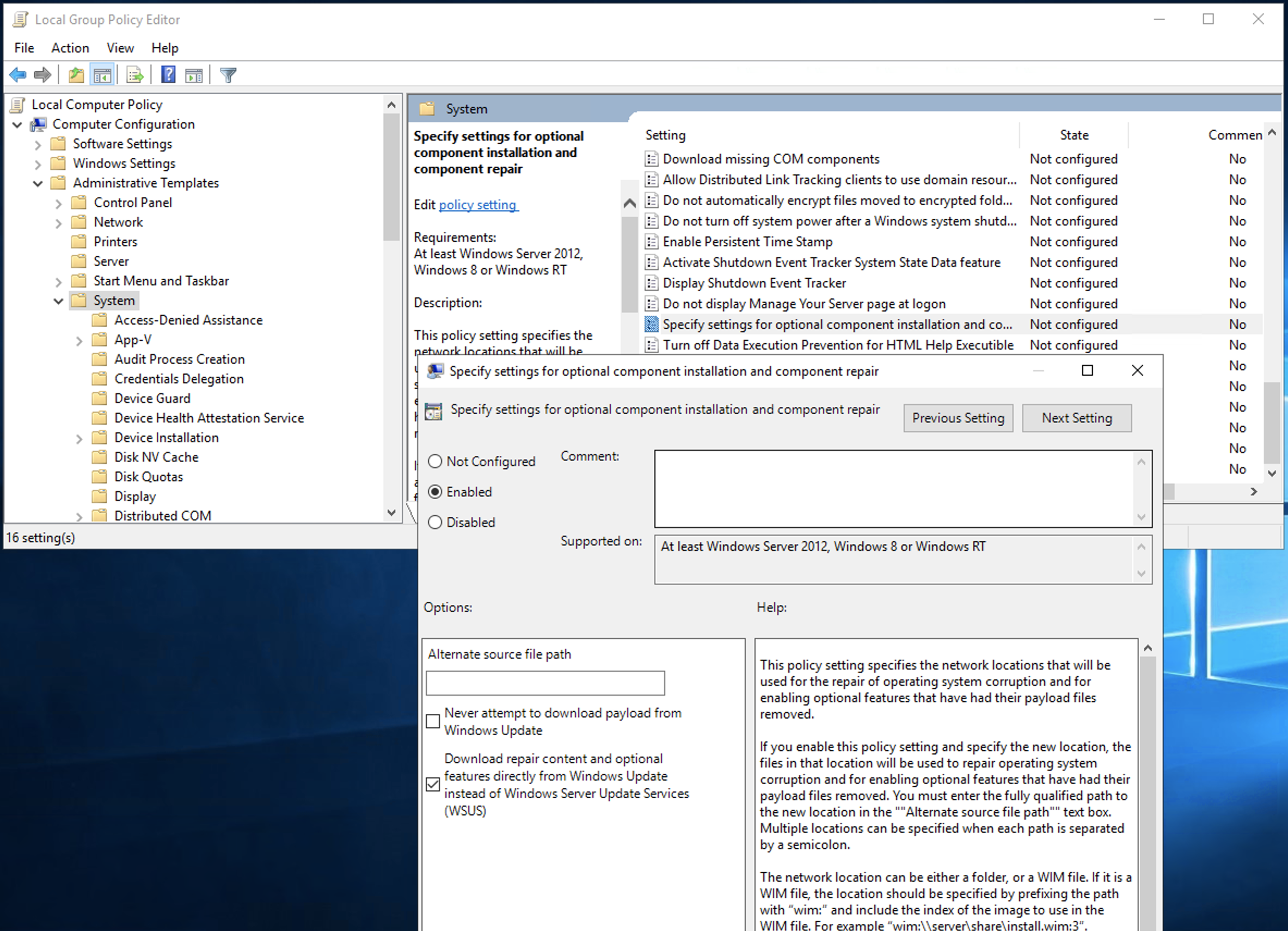
1.2.2.9 -- win dism 0x800f0954 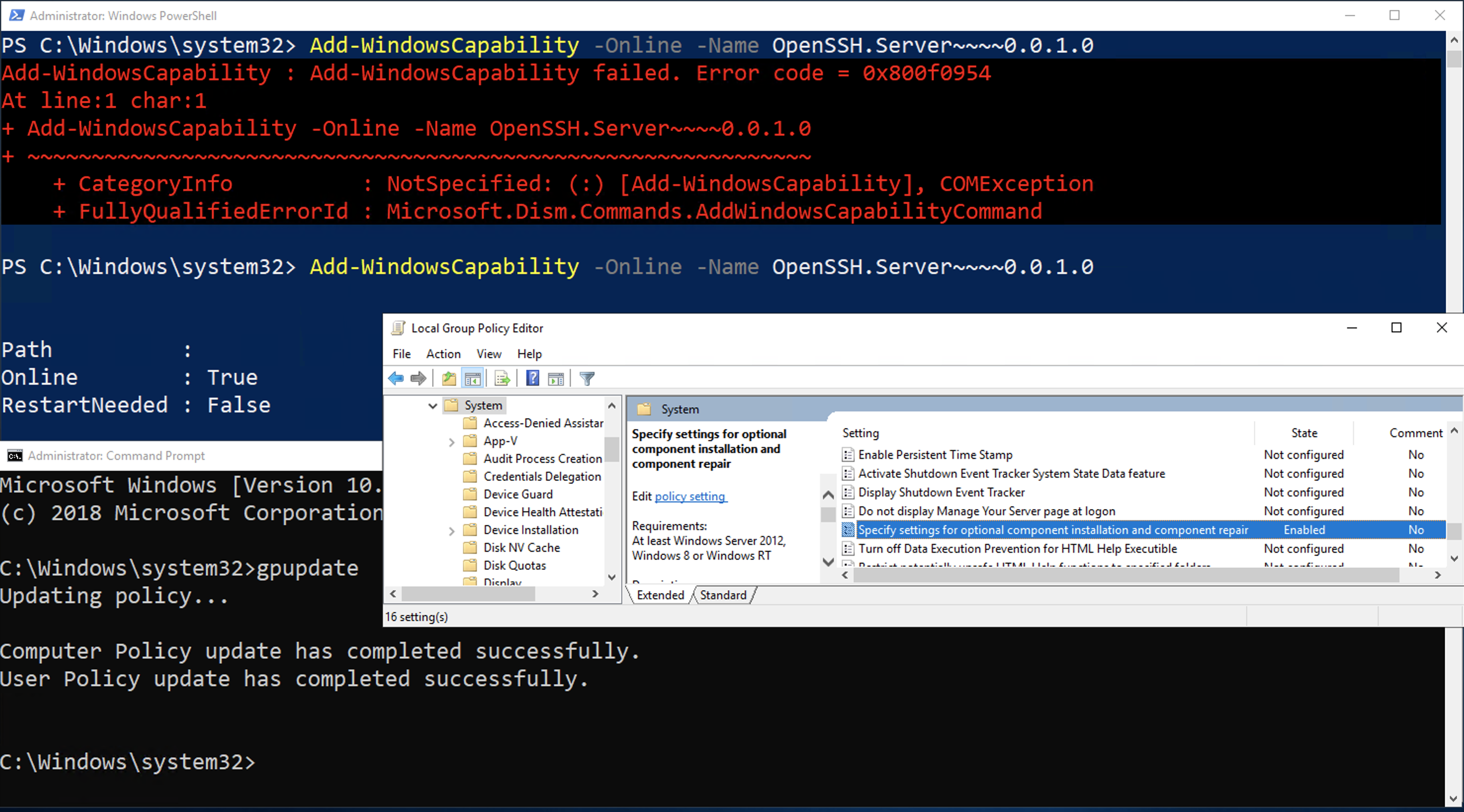
1.2.2.10 -- win gpedit 0x800f0954 verify
> Get-WindowsCapability -Name OpenSSH.Server~~~~0.0.1.0 -Online | Add-WindowsCapability -Online # for rast > Get-WindowsCapability -Name Rsat.ActiveDirectory.DS-LDS.Tools~~~0.0.1.0 -Online | Add-WindowsCapability -Online
- win + r ->
via
wuauserv[!NOTE|label:references]
$currentWU = Get-ItemPropertyValue -Path "HKLM:\SOFTWARE\Policies\Microsoft\Windows\WindowsUpdate\AU" -Name "UseWUServer" Set-ItemProperty -Path "HKLM:\SOFTWARE\Policies\Microsoft\Windows\WindowsUpdate\AU" -Name "UseWUServer" -Value 0 Restart-Service wuauserv # install Get-WindowsCapability -Name OpenSSH* -Online | Add-WindowsCapability –Online Set-ItemProperty -Path "HKLM:\SOFTWARE\Policies\Microsoft\Windows\WindowsUpdate\AU" -Name "UseWUServer" -Value $currentWU Restart-Service wuauserv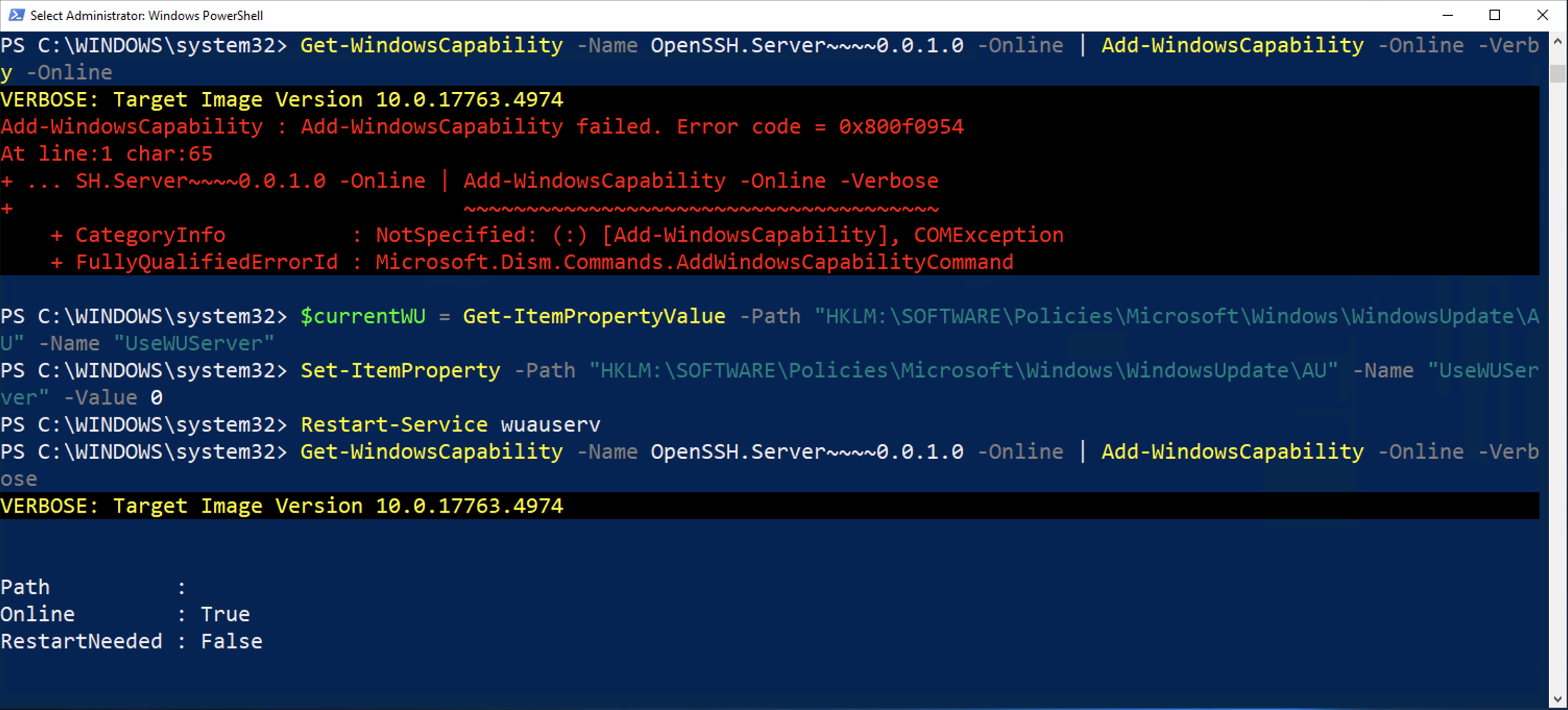
1.2.2.11 -- win openssh 0x800F0954 - or
$currentWU = Get-ItemPropertyValue -Path "HKLM:\SOFTWARE\Policies\Microsoft\Windows\WindowsUpdate\AU" -Name "UseWUServer" $currentWUAccess = Get-ItemPropertyValue -Path "HKLM:SOFTWARE\Policies\Microsoft\Windows\WindowsUpdate" -Name "DisableWindowsUpdateAccess" Set-ItemProperty -Path "HKLM:\SOFTWARE\Policies\Microsoft\Windows\WindowsUpdate\AU" -Name "UseWUServer" -Value 0 Restart-Service wuauserv # install Get-WindowsCapability -Name OpenSSH* -Online | Add-WindowsCapability –Online Set-ItemProperty -Path "HKLM:\SOFTWARE\Policies\Microsoft\Windows\WindowsUpdate\AU" -Name "UseWUServer" -Value $currentWU Set-ItemProperty -Path HKLM:SOFTWARE\Policies\Microsoft\Windows\WindowsUpdate -Name DisableWindowsUpdateAccess -Value $currentWUAccess Restart-Service wuauserv
- or